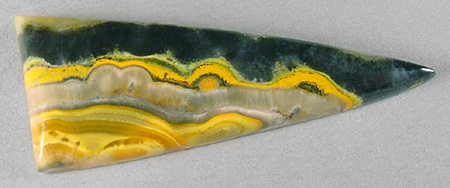Lapidary and safety
Anyone who saws, sands, grinds or polishes rocks should be aware that the dust generated poses health hazards, yet I can’t begin to count how many times I have seen fellow lapidarists busy at their cabbing or faceting machines bare-faced. And thus unprotected. Grinding with water certainly helps, but that alone is not enough. Wet grinding still generates plenty of mist-borne silica dust, which can be inhaled or ingested. Inhalation of ground rock & many rock polishes, (think: microscopic razor blades), can put one at risk of developing silicosis, and believe me, you don’t ever want to go there! A good quality mask is an absolute necessity, even for hobbyists who only occasionally do lapidary work.
Some serpentines, as well as Arizona and California tigereyes (chrysotile), actually contain fibrous asbestos. If you must work with such materials, I recommend a respirator, and doing the work outdoors.
Rubber or latex gloves are another safety aid I keep in stock and use regularly. For some messy materials like psilomelane, hematite or marcasite, gloves do a lot to help keep my hands clean so I don’t have to scrub them raw. But certain materials are of far greater concern, such as mohawkite, pyrite, malachite, cinnabar & cobalt ores, and other heavy metals. Taking steps to protect one’s health is just common sense, yet the issue is all too often neglected. Lapidary materials can and do contain arsenic, copper, lead, mercury, beryllium and a laundry list of other toxic elements, many of which can pass right through the skin and build up in one’s tissues, potentially causing great harm. (I strongly suspect that the bright sulfur yellows of the new bumblebee “jasper” from Indonesia may include realgar and/or orpiment, and wish someone would have that tested so we know for sure…)

Other lapidary materials can even be radioactive. Like certain examples of dinosaur bone (carnotite) & other fossils, as well as some old yellow art glass (uranium).
Please bear in mind that the above examples represent only the tip of the iceberg; by no means is this a complete picture of the possible dangers any lapidary can encounter. I do hope it’s enough to get your attention. Lapidary work should be a fun and enjoyable endeavor, but clearly, what you don’t know CAN kill you!
So be sure to glove up, mask up, and keep your machines as clean as possible.